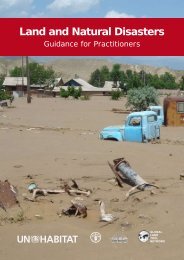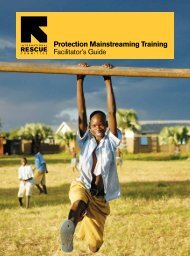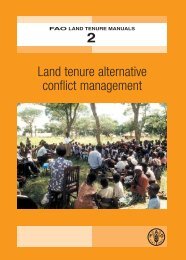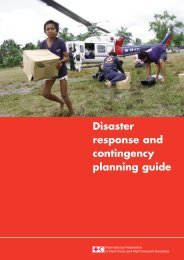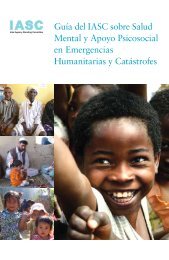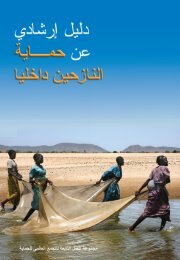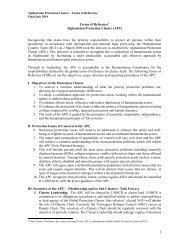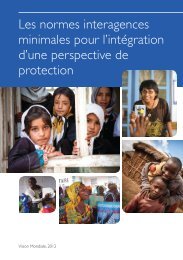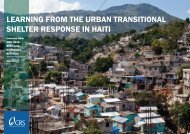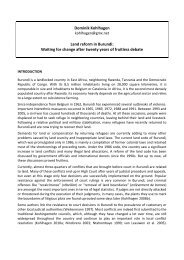Inter-Agency Real Time Evaluation of the Response to Cyclone Nargis
Inter-Agency Real Time Evaluation of the Response to Cyclone Nargis
Inter-Agency Real Time Evaluation of the Response to Cyclone Nargis
You also want an ePaper? Increase the reach of your titles
YUMPU automatically turns print PDFs into web optimized ePapers that Google loves.
OCHA on how <strong>to</strong> support MIMU caused some delay) MIMU was soon producing and disseminatinguseful materials including maps, meeting minutes, etc.At <strong>the</strong> time <strong>of</strong> <strong>the</strong> IA RTE visit <strong>to</strong> Myanmar, MIMU was still producing a range <strong>of</strong> products, many<strong>of</strong> which were appreciated by agency staff, and all <strong>of</strong> <strong>the</strong> clusters at Yangon level were supported byinformation managers. However, many international and national agencies expressed concerns that<strong>the</strong> “who-what-where” (WWW) data was <strong>of</strong> only limited value as it <strong>of</strong>ten did not provide sufficientdetail for planning purposes and failed <strong>to</strong> differentiate between an organization with a significant,long-term presence and a one-<strong>of</strong>f relief distribution. Many agency staff, particularly at hub level,felt overburdened with constant information demands while expressing doubts about <strong>the</strong> reliability<strong>of</strong> data being produced. The IA RTE team observed that a lack <strong>of</strong> credible data had both a negativeimpact on efficiency since agencies tended <strong>to</strong> conduct <strong>the</strong>ir own assessments ra<strong>the</strong>r than rely onWWW data, and on coverage, as <strong>the</strong> data did not adequately highlight <strong>the</strong> worst-affected areas inBogalay Township that remained underserved.As with <strong>the</strong> clusters more generally, agency staff at hub level have not been adequately involved inIM. Beyond <strong>the</strong> substantial investment <strong>of</strong> staff time in ga<strong>the</strong>ring data <strong>the</strong> IA RTE team observedlittle IM capacity at hub level. Information from national organizations and non-traditional ac<strong>to</strong>rs(e.g. <strong>the</strong> private sec<strong>to</strong>r) appeared <strong>to</strong> be even more limited.3.7 PlanningHumanitarian strategic planning has not been particularly strong during <strong>the</strong> <strong>Nargis</strong> response.<strong>Inter</strong>viewees indicated that this was hampered both by <strong>the</strong> lack <strong>of</strong> a completed contingency plan thatcould have provided greater guidance on activities and roles and also <strong>the</strong> high level <strong>of</strong> uncertainty(e.g. about access) that prevailed during <strong>the</strong> initial weeks. Planning that has occurred has mostlybeen ‘s<strong>to</strong>ve piped’ within clusters, but not necessarily within a coherent, holistic, view <strong>of</strong> what <strong>the</strong>international community was trying <strong>to</strong> achieve in <strong>the</strong> Delta.A contingency planning process had begun in Myanmar but was still incomplete when <strong>Nargis</strong> hit,but <strong>the</strong> process itself tangibly benefited a coordinated response, with <strong>the</strong> creation <strong>of</strong> a regional andin-country IASC as one striking example. Prior <strong>to</strong> <strong>Nargis</strong>, both <strong>the</strong> regional IASC in Bangkok and<strong>the</strong> IASC in Myanmar was viewed by INGOs as having limited utility (“more UN meetings”). But<strong>the</strong>re was broad acknowledgement amongst both UN and INGO interviewees that both IASCmechanisms more than proved <strong>the</strong>ir value-added once an emergency response was required. Thefact that <strong>the</strong> mechanism was already established and <strong>the</strong>re were pre-existing relationships facilitatedtimely decision-making. Ano<strong>the</strong>r example, already cited above, was <strong>the</strong> rapid appointment <strong>of</strong> clusterleads.3.8 Capacity BuildingAs described above, <strong>the</strong> response <strong>to</strong> <strong>Nargis</strong> has been predominantly a local one. Civil society canno<strong>the</strong>lp but be streng<strong>the</strong>ned through <strong>the</strong> hands-on experience gained by literally thousands <strong>of</strong> nationalvolunteers and staff who, in most cases, are getting <strong>the</strong>ir first opportunity <strong>to</strong> manage projects,develop operational plans, and (one hopes) see <strong>the</strong> immediate impact <strong>of</strong> <strong>the</strong>ir work. Someinternational organizations have prioritized working directly with civil society groups at <strong>the</strong> villagelevel on humanitarian activities.23



